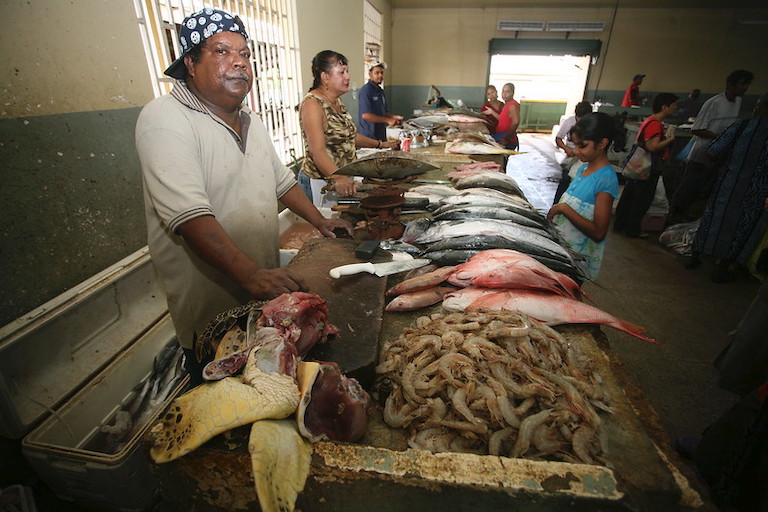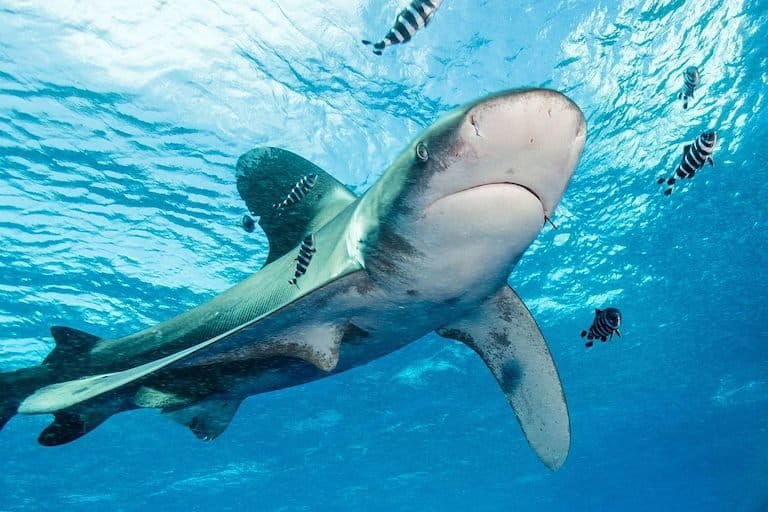- The term “aquatic wild meat,” or “marine bushmeat,” refers to the hunting of marine mammals, reptiles, seabirds and now some sharks and rays.
- The hunting takes place all over the world and has increased in recent years as small-scale fishers have lost access to fish and other marine resources.
- Last week, delegates representing more than 80 countries took steps to address the issue of aquatic wild meat at the Convention on the Conservation of Migratory Species of Wild Animals conference in Gandhinagar, India.
- Other outcomes of the conference included adding 10 new species to the convention’s protected lists, including the jaguar and Asian elephant, recognizing the culture of wild animals, and calling for migratory species to be considered in national climate and energy policies.
Scientists and conservationists have long expressed concern about the consumption of bushmeat, mindful of its impact on wildlife and human health. Yet the marine equivalent has received relatively little attention, even as dwindling resources have led more small-scale fishers in places such as West Africa to target dolphins, sea turtles and other mammals, reptiles and birds considered “aquatic wild meat.”
Delegates representing more than 80 countries took steps to address the issue at the Convention on the Conservation of Migratory Species of Wild Animals (CMS) conference in Gandhinagar, India, which concluded on Feb. 22. They agreed to develop an aquatic wild meat action plan for West Africa and to coordinate global protection efforts for species targeted as aquatic wild meat, including, for the first time, certain sharks and rays.
“Aquatic wild meat is on the rise and CMS is acknowledging that it is a fast-emerging threat on a scale similar to that facing terrestrial animals,” Fabienne McLellan, who attended the conference as co-director of international relations at OceanCare, a marine conservation NGO based in Switzerland, told Mongabay in an email. “People’s reliance on aquatic wild meat is growing across tropical, temperate, sub-Arctic as well as Arctic regions. So whales, dolphins, manatees, turtles, crocodiles, and seabirds are increasingly being targeted as a direct consequence of declining fish stock.”
Some NGO participants were not fully satisfied with the steps that CMS parties took, given the urgency to protect these species, many of which have long life spans and are slow to reproduce. But they expressed hope that this will mark the beginning of a broader push to protect overexploited aquatic wild meat species.

Aquatic wild what?
Scientists began speaking about aquatic wild meat in the 1990s and 2000s, initially calling it “marine bushmeat.” Threats to the concerned species have multiplied since then. Globally, people intentionally kill about 100,000 small whales, dolphins and porpoises from at least 56 species every year, according to a 2019 report by multiple conservation groups. Recent research shows that the number of small cetaceans killed in hunts is increasing, including in places such as the Amazon basin and the waters near Ghana.
The hunt is not always driven by an immediate need for protein. In Latin America and Asia, people use the flesh and blubber of small cetaceans for bait because of its durability on hooks and its desirability to targeted fish species. In West Africa, people seek dolphin oil as a medicinal cream for children.
Some aquatic wild meat hunting is illegal, such as the extensive sea turtle poaching in the “Coral Triangle” region of Southeast Asia. However, much of it is legal. Many countries don’t have legislation that protects aquatic wild meat species. (The Marine Mammal Protection Act in the U.S. is a strong exception.)
For example, many Caribbean island nations have no laws protecting small whales and dolphins. People on the main island of St. Vincent and the Grenadines hunt several hundred small cetaceans per year, according to Russell Fielding, a visiting environmental studies lecturer at the University of the West Indies in Barbados. This hunting gets less attention than that on the small Grenadine island of Bequia, which uses a special aboriginal license from the International Whaling Commission, the body that regulates catch of large whales, to hunt four humpback whales (Megaptera novaeangliae) per year. However, the lower-profile hunting on St. Vincent accounts for a lot more biomass, Fielding said.

Eating aquatic wild meat poses serious public health risks, he said. The small cetaceans in the area are apex predators that concentrate pollutants, which have moved up the food chain, in their tissues.
“When people eat them, we become the apex predator, and we ingest all these pollutants,” Fielding told Mongabay. His research indicates that the mammals’ muscles, blubber and internal organs are full of microplastics and industrial pollutants such as mercury. Every sample of small-cetacean tissue his teams have tested has had mercury levels above the threshold considered safe by the World Heath Organization — on average 3 to 48 times the recommended limit.
Fielding said he’s moved from focusing solely on research to becoming something of an activist in trying to spread the word about these dangers. So far, though, governments in the eastern Caribbean haven’t taken action to curtail the consumption of aquatic wild meat, he said.
Driven to hunt
The growth in demand for aquatic wild meat is likely due to global consumption of other marine resources, which has increased significantly since 1950, according to the Food and Agriculture Organization of the United Nations. Climate breakdown has played a role by, for example, shifting the locations of fish further offshore where small-scale fishers can’t access them. Scientists have found that decreased fish availability can lead to more hunting of terrestrial bushmeat in coastal areas, and now the same hunting trend can be seen at sea.
Efforts to curb local hunts have been largely ineffective, and in some cases may have backfired by inspiring local resistance to outsider values. Some conservationists are now pushing for an approach that addresses the root causes of the hunting phenomenon, and in West Africa industrial overfishing is a big one, according to Maximin Djondo, an aquatic wild meat specialist at OceanCare. There, industrial fishing vessels outperform local fishers by more than 20 times, according to a 2016 OceanCare report.
“Fishers get less and less fish due to international vessels, mostly Chinese, that come into West African waters and take everything,” Djondo, who’s based in Benin, told Mongabay. “People now don’t get as many fish, so they’re more interested in aquatic wild meat.”
OceanCare expressed disappointment that the CMS conference did not lead to concrete action to address overexploitation by industrial vessels. “There is no change from ‘business as usual,’” its delegates to the conference wrote in a press release.

The convention’s impact
The legality of hunting many marine species is difficult to determine. CMS strictly prohibits the take of endangered migratory species listed as Appendix I, its highest level of protection. In theory, the 130 signatory parties to CMS either automatically hold the treaty’s resolutions as law or must enact legislation that matches the resolutions. In practice, though, some countries don’t enact legislation.
Even when countries have the right laws, enforcement is difficult. The CMS secretariat has less ability to enforce its resolutions than the secretariat of a companion convention, the Convention on International Trade in Endangered Species of Wild Fauna and Flora (CITES), which can issue trade sanctions for noncompliance. Also, some countries with large foreign fishing fleets, such as China and Japan, aren’t signatories to CMS, so their flagged vessels aren’t required to comply with the convention’s provisions, according to Brett Sommermeyer, the legal director of Sea Shepherd Legal, a Seattle-based law firm affiliated with the NGO Sea Shepherd Conservation Society.

Migratory species face myriad pressures aside from hunting, and the results are dire. The first-ever review of the status of CMS-listed species, published earlier this month in preparation for the recent conference, shows that the populations of most of those species are going down, according to a CMS press release.
Even so, efforts to strengthen CMS floundered at the conference: a proposed resolution [pdf] that would have expanded the convention’s remit to include trade restrictions on species threatened with extinction failed to pass and was replaced with a call for research into the issue. The Australian and European Union delegations opposed the proposal, according to Sommermeyer, and that’s what tanked it, an OceanCare staff member who attended the conference told Mongabay. (An Australian delegate did not respond to Mongabay’s requests for comment; an EU delegate declined to comment.)
Still, observers pointed to positive developments. CMS added 10 new species to its lists conferring protected status, including seven on Appendix I: jaguar (Panthera onca), Asian elephant (Elephas maximus indicus), great Indian bustard (Ardeotis nigriceps), Antipodean albatross (Diomedea antipodensis), Bengal florican (Houbaropsis bengalensis), little bustard (Tetrax tetrax), and oceanic whitetip shark (Carcharhinus longimanus).
The parties moved to recognize the culture of wild animals, including variations in social structures, behaviors and dialects that can occur within a single species. They called for migratory species to be considered in national climate and energy policies, especially when building infrastructure, and for reduced bycatch of marine mammals in commercial fisheries.
On the final day of the conference, CMS parties released the Gandhinagar Declaration calling for the inclusion of migratory species and the concept of “ecological connectivity” into the framework adopted at the U.N. Biodiversity Conference this coming October.

Banner image: Meat from small cetaceans hangs to dry in the sun in Barrouallie, St. Vincent & the Grenadines. Image by Andy Fielding.
Citations:
da Silva, V. M., Freitas, C. E. C., Dias, R. L., & Martin, A. R. (2018). Both cetaceans in the Brazilian Amazon show sustained, profound population declines over two decades. PLOS ONE, 13(5), e0191304. doi:10.1371/journal.pone.0191304
Brashares, J. S., Arcese, P., Sam, M. K., Coppolillo, P. B., Sinclair, A. R. E., Balmford, A. (2004). Bushmeat hunting, wildlife declines, and fish supply in West Africa. Science, 306(5699), 1180-1183. doi:10.1126/science.1102425
Van Waerebeek, K., Debrah, J. S., & Ofori-Danson, P. K. (2014). Cetacean landings at the fisheries port of Dixcove, Ghana in 2013-14: a preliminary appraisal. International Whaling Commission SC/65b/SM17 (Bled), 4. doi:10.13140/RG.2.1.4079.2401
FEEDBACK: Use this form to send a message to the editor of this post. If you want to post a public comment, you can do that at the bottom of the page.
